At multiple points today my past came rushing back. As we discuss our nature collages, reflections of our experiences with nature, I am flooded with memories of farms, of lakes, of family and friends. Picking cherries in family orchards, tailgating to get to the heart of the trees, dangling from the back of the pick-up as we bounced over irrigation hoses. And camping. Thinking about spring nights spent 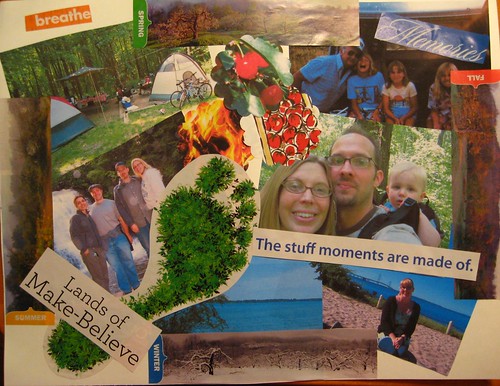 around a campfire with friends has me wanting to unbury my tent from the basement, make plans for May. Later in the day we brainstorm people, places, and experiences with nature that have defined us. I remember strongly wishing I could be a fresh water mermaid when I grew up.
around a campfire with friends has me wanting to unbury my tent from the basement, make plans for May. Later in the day we brainstorm people, places, and experiences with nature that have defined us. I remember strongly wishing I could be a fresh water mermaid when I grew up.
All of this has me thinking about just how strongly place defines us. I am tied to nature today - a home gardener, a hiker, a camper - because of my formative experiences with nature. But the way I live today - urban, technology driven, gadget geared - is so different from how I was raised. I grew up on a dirt road, in nature, orchards and lakes just outside my door. I step out the door now onto concrete. Streets and neighbors closely packed together, no open space within walking distance. What will this place mean for my sons? How will this place define them? And how can I help them make the connections to place - to nature and their place within it - that their father and I have?
I am not one to talk about myself. I find it incredibly difficult. I am much more content to listen to others, to make connections silently. However, when asked to remain silent while others talked about my collage, I had a difficult time. I wanted to jump in and explain, to show the connections, to share the stories of my connections to nature. But remaining silent gave me an opportunity to listen. Are the images that I put out to the world understood in the way that I intended? For the most part, they were, in part because I used actual photos from my life. But I was surprised by some of the ideas that weren't picked up on that I thought were clear. I thought the quotes on my collage - "the stuff moments are made of" and "Lands of Make-Believe" - made clear my idea that nature was strongly tied to memories of childhood play. But instead, my group focused on camping. Interesting. A new perspective on my own work.
For the most part, they were, in part because I used actual photos from my life. But I was surprised by some of the ideas that weren't picked up on that I thought were clear. I thought the quotes on my collage - "the stuff moments are made of" and "Lands of Make-Believe" - made clear my idea that nature was strongly tied to memories of childhood play. But instead, my group focused on camping. Interesting. A new perspective on my own work.
We need this - an audience to push our thinking, to challenge our point of view, to give us a fresh perspective. How often do I provide such opportunities to my students?
 I am certainly not an artist. Having a two-year old interested in learning the shape and form of things has taught me that. He looks at me with those big green eyes, pleading me to draw a rocket ship with his over-sized orange crayon. Nothing is more humbling. My rocket ship looks a bit like corn on the cob. But he is forgiving and asks me to draw a train instead. He claps, giddy, as I begin by drawing the engine.
I am certainly not an artist. Having a two-year old interested in learning the shape and form of things has taught me that. He looks at me with those big green eyes, pleading me to draw a rocket ship with his over-sized orange crayon. Nothing is more humbling. My rocket ship looks a bit like corn on the cob. But he is forgiving and asks me to draw a train instead. He claps, giddy, as I begin by drawing the engine.
He is excited about art, about creating and manipulating shapes. He draws big looping circles with his yellow crayon, clenched so tightly his knuckles are white. "Moon, mommy." A minute later it is not a moon but a planet. He does not fear the attempt at art, nor does he hesitate to reinterpret, the change. He just draws.
I take him to art class each Thursday morning. A small collection of toddlers with their moms in tow dabble in finger paint to create masks and press hand prints onto construction paper. Our children beg us to be artists with them. During the first few classes, many of us moms hesitated, content to watch over small shoulders and attempt to control the chaos that is a painting toddler. "Hey little guy, why don't you..." or "Why not try this." But toddlers resist such control; they throw tantrums when not allowed to create freely.
When did we lose this. At what point do we harness the impulse to create, to get dirty. When do we become so inhibited that we stop looking at the world with child-like glee?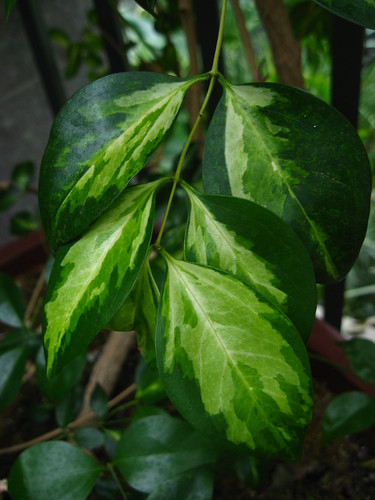 I wonder this as I'm sitting in the main garden of Longwood's conservatory, the waterfall in front of me drowning out other concerns, other voices. And the jasmine beside me perfumes the air, a lightly sweet scent to welcome the morning. Why am I writing about my son's artistic endeavors while sitting in this beautiful setting? What's the connection? It is because I am more than a bit hesitant about my own artistic abilities.
I wonder this as I'm sitting in the main garden of Longwood's conservatory, the waterfall in front of me drowning out other concerns, other voices. And the jasmine beside me perfumes the air, a lightly sweet scent to welcome the morning. Why am I writing about my son's artistic endeavors while sitting in this beautiful setting? What's the connection? It is because I am more than a bit hesitant about my own artistic abilities.
For this class I've been asked to draw what I see before me. But I've had a hard time using my pen for something other than scribbling words to make sense and make meaning. I am hesitant to try to make meaning without words, too comfortable to hide behind the camera's lens or behind words.
But this morning, I'm willing to give it a shot, break out of my comfort zone and embrace a child-like optimism about my artistic skills.
Fingers of gold reach down each leaf,
some stronger than others.
Some a proud emerald,
untouched or marbled.
The veins,
barely visible.
No bold color to mark them,
to point out where life flows.
Look closely to see
the mark to divide,
the secondary veins that course
the perimeter,
tiny fingers reaching
for the edge.
Today reinterated my need to stop, slow down, and observe. Taking time to just sit allows me to find new subjects. And what a breath of fresh air this would be for students. Students walk into our classrooms loaded down by 25 pound back packs, concerned about last night's math homework and properly formatting the lab report due tomorrow. how will I get home from practice tonight, and I don't understand why Ms. So-and-so gave me a C on my book report. As Richard Louv points out, and then as reframed by today's presentation by senior gardener  Tim Jennings, as teachers we are not in the business of selling drills. As part of his presentation, Jennings pointed out that we don't buy a drill simply to buy a drill. We buy an end result. We buy the drill so that we can build something we need. Similarly, as teachers we don't teach the comma because students need commas. We teach for the end result, so that students become clever and competent writers. Unfortunately the metaphor of selling drills that Jennings used is an apt metaphor for teaching. After all, we've learned that the "drill and kill" method of teaching is not useful. However, how often do we think of our teaching in this manner - that students need to learn this or that concept, idea, or term.
Tim Jennings, as teachers we are not in the business of selling drills. As part of his presentation, Jennings pointed out that we don't buy a drill simply to buy a drill. We buy an end result. We buy the drill so that we can build something we need. Similarly, as teachers we don't teach the comma because students need commas. We teach for the end result, so that students become clever and competent writers. Unfortunately the metaphor of selling drills that Jennings used is an apt metaphor for teaching. After all, we've learned that the "drill and kill" method of teaching is not useful. However, how often do we think of our teaching in this manner - that students need to learn this or that concept, idea, or term.
Instead, teachers must be in the business of sharing the right tools that help students come to their own polished result. As teachers it is our job to breath life into the learning process, to let students practice and find their own way, to find their own understanding. We can't do this if we take over the process for them, or as Louv said, if we build the playground for them. Teachers must give students the space to be creative, to get their hands dirty, to imagine, to make their own sense of the world. If we don't, we take a world of understanding away from our students.
The rain pounding the glass ceiling of the conservatory is a crescendoing snare drum, the drum roll growing more intense with each passing minute. And the water coursing down the metal gutters just behind me echo the sound of a hammer on a xylophone, sending wild notes echoing throughout the room.
The sound is unexpected. In a place like Longwood Gardens, I expect to write what I see. I don't know that I spend much time thinking about what I hear, too often attempting to tune out all the background noise in order to concentrate on some mundane daily task. I hear too much in my head - "Don't forget to pick up milk? We're almost out. How did I let it get so low, anyway?" - that I forget to listen to the world around me.
A cell phone rings some obnoxiously unnameable tune. And after three or four bars, a tall, dark-haired gentleman in an equally dark sweater answers. "Hello?...Oh, hello!" He walks on through the carefully cared for landscape, through the glass doors at the end of this room, and onto the next room, carrying his conversation with him.
In the stillness of this desert room, the distracted voice stands out. I'm relieved when the glass door heaves a sigh as he passes into the next room. I am thankful again for the lack of voices, content to listen to the fat plops of the rain as it sneaks through a pane overhead and puddles on the slate floor next to me.
 I'm in the pass-through room. This is the room that prior to my eldest son being able to walk, I would briskly follow the slate path in order to get to the next garden oasis, the next canvas of color in this conservatory. This room is cold, both literally and visually in terms of the winter whites that blanket the room. Ashy dusty miller, gazania, and perityle coat the floor. I am in the desert with only tiny pops of vibrant color to catch the eye.
I'm in the pass-through room. This is the room that prior to my eldest son being able to walk, I would briskly follow the slate path in order to get to the next garden oasis, the next canvas of color in this conservatory. This room is cold, both literally and visually in terms of the winter whites that blanket the room. Ashy dusty miller, gazania, and perityle coat the floor. I am in the desert with only tiny pops of vibrant color to catch the eye. This is the neglected room of the conservatory, though not by the gardeners who clearly tend to their prickly pensions lovingly. Neglected instead by visitors like myself. As I sit here, a young family quickly passes the Mexican cactus without so much as a sidelong glance on their way to the lush greens and yellows that beckon from behind the glass doors at the opposite end of this room. A group stops in front of me, a young couple, a set of parents, and the rest are perhaps a few family friends. They talk Tom and Marge Dickson and hotdogs. Funny how a place that calls us to reflect, such a contemplative setting, is so easy to block out. How often do I do this? How often do I miss what is right in front of me? I am usually just as distracted, passing through this room quickly to get to the next.
This is the neglected room of the conservatory, though not by the gardeners who clearly tend to their prickly pensions lovingly. Neglected instead by visitors like myself. As I sit here, a young family quickly passes the Mexican cactus without so much as a sidelong glance on their way to the lush greens and yellows that beckon from behind the glass doors at the opposite end of this room. A group stops in front of me, a young couple, a set of parents, and the rest are perhaps a few family friends. They talk Tom and Marge Dickson and hotdogs. Funny how a place that calls us to reflect, such a contemplative setting, is so easy to block out. How often do I do this? How often do I miss what is right in front of me? I am usually just as distracted, passing through this room quickly to get to the next.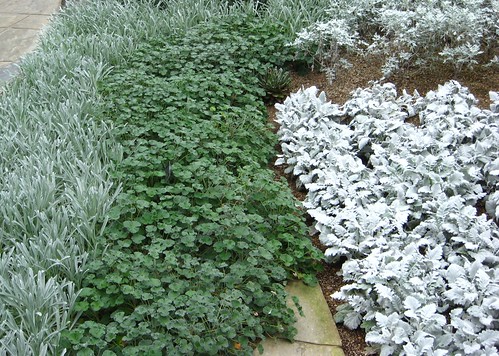 That is until Harry learned to walk. He loves this room. The cacti are "pickie" or "fuffy." The rocks, though clearly marked not for climbing, are his longed-for jungle gym. The plants, all at his level, an easy squat to sniff and ponder. Why so powdery? It is a textured room. Just his style. So much to take in - to see, to smell, to touch. But the adults, like today, quickly brush past us to the more showy rooms.
That is until Harry learned to walk. He loves this room. The cacti are "pickie" or "fuffy." The rocks, though clearly marked not for climbing, are his longed-for jungle gym. The plants, all at his level, an easy squat to sniff and ponder. Why so powdery? It is a textured room. Just his style. So much to take in - to see, to smell, to touch. But the adults, like today, quickly brush past us to the more showy rooms.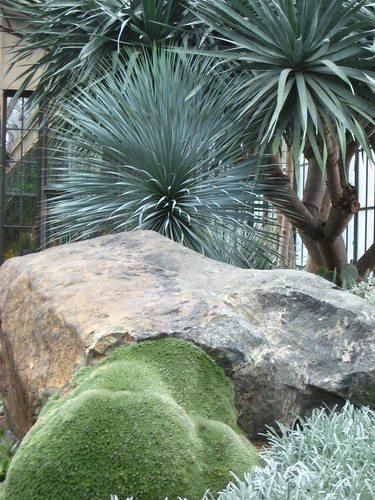 A little girl, stringy brown hair with baby-doll pink boots and matching coat, rushes in. She charges for the large rock outcropping. Pink boots kick up the cold grey stone. I wonder what she imagines this place to be.
A little girl, stringy brown hair with baby-doll pink boots and matching coat, rushes in. She charges for the large rock outcropping. Pink boots kick up the cold grey stone. I wonder what she imagines this place to be.
The other rooms are breath-taking. The orchids, so fragile, overwhelm all the senses. But they are also showy, leaving no room to imagine what if. They put it all out there on display. In contrast, this desert landscape is a blank canvas for the imagination. Like the little girl in pink boots, my son wants to climb this room. It 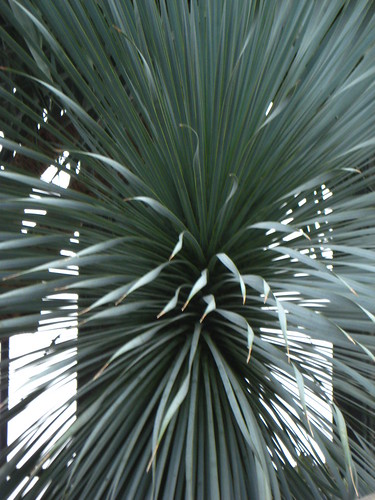 is his. There is so much that he can place on this room. Is the giant rock his own private moon, the cactus, some prickly alien life form reaching out to him? Or is the dusty miller a fresh blanket of snow in which he can make powdery snow angels? This room, which so many quickly pass through, myself included, is my son's personal playground. He is not distracted by events of the day
is his. There is so much that he can place on this room. Is the giant rock his own private moon, the cactus, some prickly alien life form reaching out to him? Or is the dusty miller a fresh blanket of snow in which he can make powdery snow angels? This room, which so many quickly pass through, myself included, is my son's personal playground. He is not distracted by events of the day 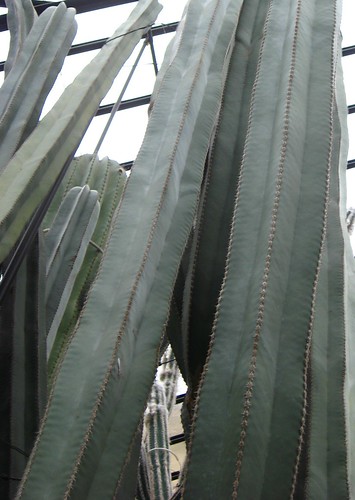 or by a ringing cell phone. He clamors around the room, taking in every leaf and thorn, amazed by it all.
or by a ringing cell phone. He clamors around the room, taking in every leaf and thorn, amazed by it all.
I can learn a lot from my little man.
 Twitter/jenniferward
Twitter/jenniferward YouTube/teacherward
YouTube/teacherward Del.icio.us/msward
Del.icio.us/msward GMail/ms.jen.ward
GMail/ms.jen.ward Blog/Teacher Et Cetera
Blog/Teacher Et Cetera